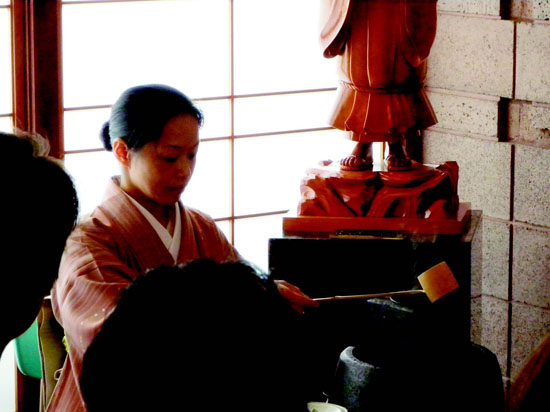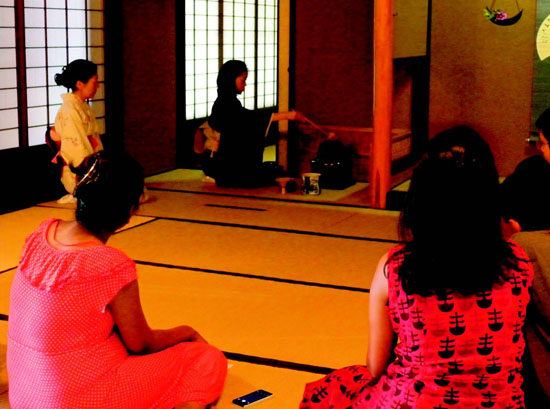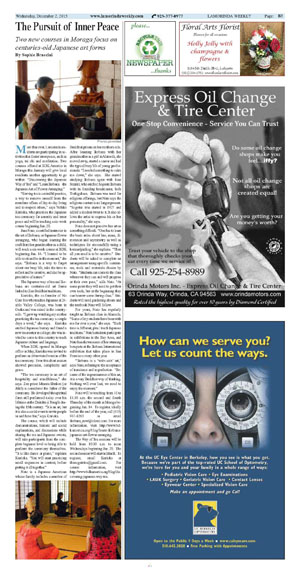|
|
Published December 16th, 2015
|
The Pursuit of Inner Peace
|
| Two new courses in Moraga focus on centuries-old Japanese art forms |
| By Sophie Braccini |
 |
| Photos provided |
More than ever, Lamorinda residents are participating in activities that foster inner peace, such as yoga, tai chi and meditation. Two courses offered at BDK America in Moraga this January will give local residents another opportunity to go within: "Discovering the Japanese Way of Tea" and "Learn Ikebana - the Japanese Art of Flower Arranging."
 "Serving tea is a mindful practice, a way to remove oneself from the mundane affairs of day-to-day living and to respect others," says Yufuko Kurioka, who practices the Japanese tea ceremony for serenity and inner peace and will be teaching a six-week course beginning Jan. 20.
"Serving tea is a mindful practice, a way to remove oneself from the mundane affairs of day-to-day living and to respect others," says Yufuko Kurioka, who practices the Japanese tea ceremony for serenity and inner peace and will be teaching a six-week course beginning Jan. 20.
 Jane Nato, a certified instructor in the art of Ikebana, or Japanese flower arranging, who began learning the craft from her grandmother as a child, will teach a six-week course at BDK beginning Jan. 14. "I learned to be able to sit and be in the moment," she says. "Ikebana is a way to forget about our busy life, take the time to reflect and be creative, and also be appreciative of nature."
Jane Nato, a certified instructor in the art of Ikebana, or Japanese flower arranging, who began learning the craft from her grandmother as a child, will teach a six-week course at BDK beginning Jan. 14. "I learned to be able to sit and be in the moment," she says. "Ikebana is a way to forget about our busy life, take the time to reflect and be creative, and also be appreciative of nature."
 The Japanese way of tea and Ikebana are centuries-old art forms linked to Zen Buddhist traditions.
The Japanese way of tea and Ikebana are centuries-old art forms linked to Zen Buddhist traditions.
 Kurioka, the co-founder of No Gate Tea who teaches Japanese at Diablo Valley College, was born in Osaka and was raised in the countryside. "I grew up watching my mother practicing the tea ceremony a couple days a week," she says. Kurioka studied Japanese history and found a new tea mentor in college; she was invited to come to this country to teach Japanese culture and language.
Kurioka, the co-founder of No Gate Tea who teaches Japanese at Diablo Valley College, was born in Osaka and was raised in the countryside. "I grew up watching my mother practicing the tea ceremony a couple days a week," she says. Kurioka studied Japanese history and found a new tea mentor in college; she was invited to come to this country to teach Japanese culture and language.
 When BDK opened its Moraga office in May, Kurioka was invited to perform an abbreviated version of the tea ceremony. Even this short session showed precision, complexity and grace.
When BDK opened its Moraga office in May, Kurioka was invited to perform an abbreviated version of the tea ceremony. Even this short session showed precision, complexity and grace.
 "The tea ceremony is an art of hospitality and mindfulness," she says. Zen priest Murata Shukou (or Juko) is considered the father of the ceremony. He developed the spiritual form still performed today over his lifetime at the Daitoku-ji Temple during the 15th century. "It is an art, but it is also a social event to invite people in and have fun," says Kurioka.
"The tea ceremony is an art of hospitality and mindfulness," she says. Zen priest Murata Shukou (or Juko) is considered the father of the ceremony. He developed the spiritual form still performed today over his lifetime at the Daitoku-ji Temple during the 15th century. "It is an art, but it is also a social event to invite people in and have fun," says Kurioka.
 The course, which will include demonstrations, historic and social explanations, and discussions while sharing the tea and Japanese sweets, will take participants from the complete beginner level to being able to perform the ceremony themselves. "It is like dance or piano," explains Kurioka. "You will start practicing small sequences in context, before putting it all together."
The course, which will include demonstrations, historic and social explanations, and discussions while sharing the tea and Japanese sweets, will take participants from the complete beginner level to being able to perform the ceremony themselves. "It is like dance or piano," explains Kurioka. "You will start practicing small sequences in context, before putting it all together."
 Nato is a Japanese American whose family includes a number of Buddhist priests on her mother's side. After learning Ikebana with her grandmother as a girl in Alameda, she moved away, started a career and had the typical busy life of young professionals. "I needed something to calm me down," she says. She started studying Ikebana again with Joan Suzuki, who studied Sogestu Ikebana with its founding headmaster, Sofu Teshigahara. Ikebana was used for religious offerings, but Nato says the religious content is no longer present. "Sogetsu was started in 1927 and added a modern twist to it. It also allows the artist to express his or her personality," she says.
Nato is a Japanese American whose family includes a number of Buddhist priests on her mother's side. After learning Ikebana with her grandmother as a girl in Alameda, she moved away, started a career and had the typical busy life of young professionals. "I needed something to calm me down," she says. She started studying Ikebana again with Joan Suzuki, who studied Sogestu Ikebana with its founding headmaster, Sofu Teshigahara. Ikebana was used for religious offerings, but Nato says the religious content is no longer present. "Sogetsu was started in 1927 and added a modern twist to it. It also allows the artist to express his or her personality," she says.
 Nato does not perceive her art as something difficult. "One has to learn the basic rules about line, mass, dimension and asymmetry as well as techniques for successfully using a kenzan/pinfrog," she explains. "Then all you need is to be creative." Students will be asked to complete an arrangement using specific containers, tools and materials chosen by Nato. "Students can come to the class whenever they can and will progress at their own pace," adds Nato. "At some point they will need to get their own tools, but at the beginning they can borrow some during class." Students will need gardening sheers and the textbook Nato will follow.
Nato does not perceive her art as something difficult. "One has to learn the basic rules about line, mass, dimension and asymmetry as well as techniques for successfully using a kenzan/pinfrog," she explains. "Then all you need is to be creative." Students will be asked to complete an arrangement using specific containers, tools and materials chosen by Nato. "Students can come to the class whenever they can and will progress at their own pace," adds Nato. "At some point they will need to get their own tools, but at the beginning they can borrow some during class." Students will need gardening sheers and the textbook Nato will follow.
 For years, Nato has regularly taught an Ikebana class in Alameda. "Some of my students have been with me for over a year," she says. "Each time is different, plus I teach Japanese traditions." Nato's students participate in exhibitions in the Bay Area, and Nato has shown some of her stunning bouquets at the Ikebana International exhibition that takes place in San Francisco every other year.
For years, Nato has regularly taught an Ikebana class in Alameda. "Some of my students have been with me for over a year," she says. "Each time is different, plus I teach Japanese traditions." Nato's students participate in exhibitions in the Bay Area, and Nato has shown some of her stunning bouquets at the Ikebana International exhibition that takes place in San Francisco every other year.
 "Ikebana is a 'wabi-sabi' art," says Nato, referring to the acceptance of transience and imperfection. "Because of the impermanence of this art, it is a very Buddhist way of thinking. Nothing will ever last, we need to enjoy the moment."
"Ikebana is a 'wabi-sabi' art," says Nato, referring to the acceptance of transience and imperfection. "Because of the impermanence of this art, it is a very Buddhist way of thinking. Nothing will ever last, we need to enjoy the moment."
 Nato will be teaching from 10 to 11:30 a.m. the second and fourth Thursday of the month in Moraga beginning Jan. 14. To register, ideally before the end of the year, call (415) 937-8260 or email ikebana_now@icloud.com. For more information, visit http://www.bdkamerica.org/blog/learn-ikebana-japanese-art-flower-arranging.
Nato will be teaching from 10 to 11:30 a.m. the second and fourth Thursday of the month in Moraga beginning Jan. 14. To register, ideally before the end of the year, call (415) 937-8260 or email ikebana_now@icloud.com. For more information, visit http://www.bdkamerica.org/blog/learn-ikebana-japanese-art-flower-arranging.
 The Way of Tea sessions will be held from 10:30 a.m. to noon Wednesdays beginning Jan. 20. The second session will start in March. To register, email Kurioka at thenogatetea@gmail.com. For course information, visit http://www.bdkamerica.org/blog/discovering-japanese-way-tea.
The Way of Tea sessions will be held from 10:30 a.m. to noon Wednesdays beginning Jan. 20. The second session will start in March. To register, email Kurioka at thenogatetea@gmail.com. For course information, visit http://www.bdkamerica.org/blog/discovering-japanese-way-tea.

|
 |
| |
|
|
|
|
|
|
 |
|
|
|
|





